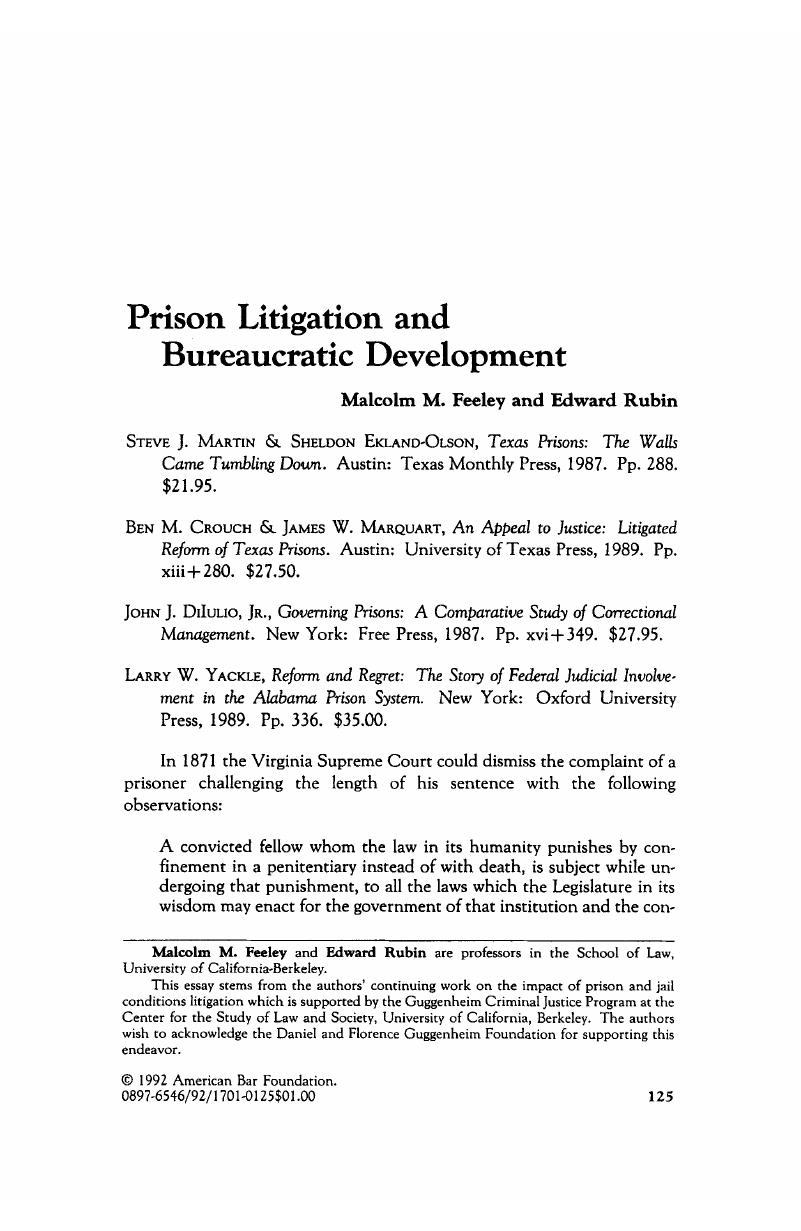Article contents
Prison Litigation and Bureaucratic Development
Published online by Cambridge University Press: 27 December 2018
Abstract

- Type
- Review Essay
- Information
- Copyright
- Copyright © American Bar Foundation, 1992
References
1 Ruffin v. Commonwealth, 26 Va. 720 (1871).Google Scholar
2 For an overview see Jacobs, James, “The Prisoners' Rights Movement and Its Impacts,”in Norval Morris & Michael Tonry, eds., 2 Crime and Justice 429–70 (Chicago: University of Chicago Press, 1980), and Malcolm M. Feeley & Roger A. Hanson, “The Impact of Jail and Prison Corrections Litigation,”in John J. Dilulio, ed., Courts, Corrections and the Constitution (New York: Oxford University Press, 1990).Google Scholar
3 See, e.g., Smolla, Rodney, “Prison Overcrowding and the Courts: A Road Map for the 1980s,” 1984 U. Ill. L. Rev. 389.Google Scholar
4 Fiss, Owen, “The Supreme Court, 1978 Term—Foreword: The Forms of Justice,” Harv. L. Rev. 93 1 (1979).CrossRefGoogle Scholar
5 There were most certainly cutbacks and decisions by both the U.S. Supreme Court and the courts of appeal. Despite this the numbers and scope of cases continued to grow. See, e.g., the periodic bulletins issued by the National Prison Project of the American Civil Liberties Union. Despite the rise of a conservative judiciary, the numbers of suits and institutions under court order continued to grow throughout the 1980s.Google Scholar
6 An early and impressive effort was the monograph by M. Kay Harris & Dudley P. Spiller, Jr., After Decision: Implementation of Judicial Decrees in Correctional Settings (Washington, D.C.: NILECJ, Oct. 1977). The report was a detailed study of the implementation of court orders in four cases.Google Scholar
7 503 F. Supp. 1265 (1980).Google Scholar
8 Pugh v. Sullivan, 406 F. Supp. 318 (1976); James v. Wallace, 382 F. Supp. 1177 (1974).Google Scholar
9 In addition, there is a growing list of master's and doctoral theses that deal with the problems of implementing court orders in prison and jail conditions suits. Among those we are aware of are Bradley Chilton, “Guthrie v. Evans: Civil Rights, Prison Reform, and Institutional Reform Litigation” (Ph.D. thesis, Department of Political Science, University of Georgia, 1988); Richard Liles, “An Analysis of the Use of Special Masters for Assuring Compliance with Judicial Decrees in Corrections Litigation” (D.P.A. thesis, Center for Public Administration, Western Michigan University, 1987); Anthony Newland, “Managing Prisons: Conditions of Confinement Litigation—Lessons for California Administrators” (Ph.D. thesis, Golden Gate University, 1990); Wayne Welch, “A Comparative Analysis of Court Orders against California County Jails: Intervention and Impact” (Ph.D. thesis, Social Ecology, University of California at Irvine. 1990); Mary Parker, “Judicial Intervention in Correctional Institutions: The Arkansas Odyssey” (Ph.D. thesis, Sam Houston State University, 1985).Google Scholar
10 The moment of revelation is presented dramatically in Martin & Ekland-Olson's book; according to the book the key information was provided by one of the authors, Steve Martin, who at the time was a lawyer for the director of the Department of Corrections. As a former guard and long-time correctional employee, Martin was well aware of the crucial role played by building tenders. He asserts that the turning point in the public feature of the case came when he went to the attorney general, who up until then had believed the TDC claim that building tenders had no supervisory control over inmates, and informed him that in fact department officials were lying.Google Scholar
11 The litigation also commenced shortly after Beto retired and was replaced by James Estelle, who had not previously held positions in the TDC and had a quite different administrative style. It is interesting to speculate just how much of the dislocation and administrative turmoil was a consequence of problems of succession.Google Scholar
12 At 216 they state that “homicides in TDC fell from twenty-seven in 1985 to five and three in 1986 and 1987, respectively [lower than they had been in many years].” Similarly disciplinary cases involving weapons dropped from a high in 1985 to less than two hundred in 1987 (id.).Google Scholar
13 Dilulio's views are summarized in his recent essay, “Understanding Prisons: The New Old Penology,” 16 Law & Soc. Inquiry 65 (1991).Google Scholar
14 It is interesting to note char two of these four authors have served as guards in Texas prisons. Marquart worked as a guard and wrote his thesis on guards in Texas prisons, and Martin was a guard and later an attorney for TDC and was involved in the Ruiz case for a period.Google Scholar
15 Wyatt v. Stickney, 325 F. Supp. 781 (1971).Google Scholar
16 See, e.g., Mark T. Carleton, Politics and Punishment: A History of the Louisiana State Penal System (Baton Rouge: Louisiana State University Press, 1971); Blake McKelvey, American Prisons: A History of Good Intentions (Montclair, N.J.: Patterson Smith, 1977); Malcolm M. Feeley, “The Significance of Prison Conditions Cases: Budgets and Regions,” 23 Law & Soc'y Rev. 273 (1989); Malcolm M. Feeley & Edward Rubin, “Federal State Relations and Prison Administration,”in Harry Scheiber & Malcolm M. Feeley, eds., Power Divided: Essays on the Theory and Practice of Federalism 63–75 (Berkeley, Cal.: Institute of Governmental Studies, 1989).Google Scholar
- 7
- Cited by


